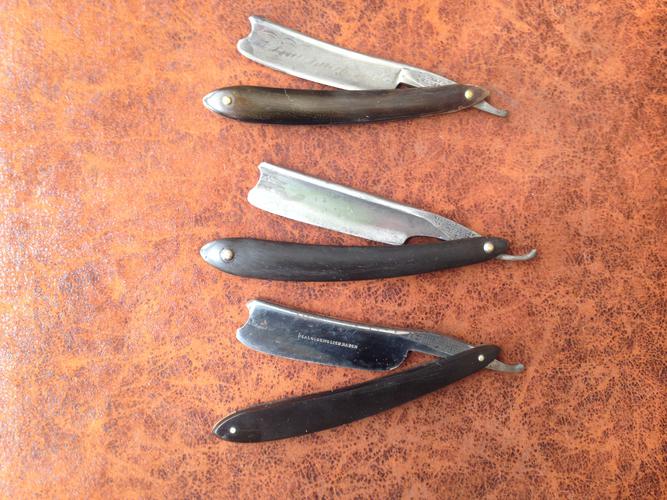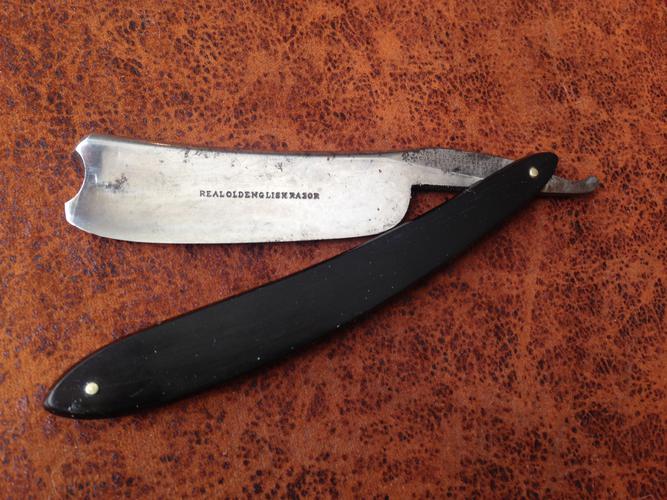Results 1 to 10 of 12
-
03-06-2017, 12:15 AM #1
 Help w/ ordering by age a few old sheffield straights
Help w/ ordering by age a few old sheffield straights
Good afternoon everyone. I like to organize the razors in my collection chronologically. Below is pictured three in my collection that I am unsure how to order. I know they are all mid 19th century blades. Any help would be appreciated.

The top razor is a Joseph Elliot with Fine India Steel etched on the blade. Not sure of date

The second one is a Wade and Butcher. Faux Frameback or "Rattler". Not sure what to call it. As a guess I would date it to the early 1850s

The last one is a Joseph Rodgers. Heavy and beautiful. I would guess later 1850's to 1860 or so.

I would really appreciate any and all input on these three in terms of their relative age and how to order them. As always, thanks in advance.Last edited by Moonbow; 03-06-2017 at 12:17 AM.
-
03-06-2017, 12:26 AM #2

This is my educated guess, I believe the bottom razor is your eldest, then your w&b and Elliot are very close in age. I would say you are pretty close with the top 2 1850's to 1860's and the bottom I would say 1840's to 1850's. This is only my guesstimate I am sure someone more knowledgeable will be along. Martin, Voidmonster one of these guys should be able to get you more accurate info. Nice razors BTW
 Nothing is fool proof, to a sufficiently talented fool...
Nothing is fool proof, to a sufficiently talented fool...
-
03-06-2017, 12:46 AM #3

The Elliot, no sons would be no later than 1856 correct?
The other two my guess would be 1850s-1860s for the Joseph Rodgers,
1870s-1880s for the Wade & Butcher.
All my guessing aside I will have to digress and quote Voidmonster " Style alone doesn't really get us there, and tail length & shape is not the indicator we would really hope for....The only remaining indicator is manufacturer's stamp."
With the date ranges for W&B and JR being as they were there is little more here to nail down a definitive date for those two me thinks Silverloaf
Silverloaf
-
03-06-2017, 02:46 AM #4Historically Inquisitive



- Join Date
- Aug 2011
- Location
- Upstate New York
- Posts
- 5,782
- Blog Entries
- 1
Thanked: 4249
My opinion 1st is the Elliot, 2nd Wade & Butcher, 3rd J. Rodgers. Reason being that I put the Wade & Butcher in second place is that there is documentation about this type of grind before 1850, since the Wade & Butcher doesn't tell us anything the tail is very reminiscent of 1845+- razors.
-
03-06-2017, 03:28 AM #5

You are absolutely right and if I had thought a little harder about that I could provide the documented proof myself haha! I own a W&B blade in this style marked "Bolles & Hastings" which I do believe dates to that time frame. Prior to 1843-ish. I will have to dig it out and snap some pics.
Silverloaf
-
03-07-2017, 06:32 PM #6

Thanks for your input on this question. My instincts led me to order them as I did in the fist pic, oldest on top. Glad there is consensus on this.
I have read that the "Fine India Steel" etchings were simply a marketing ploy and really do not actually reflect any real difference in the type of steel being used in and around the workshops of Sheffield. is this still the commonly held belief among collectors/users?
-
03-07-2017, 06:41 PM #7
-
03-07-2017, 07:11 PM #8
-
03-08-2017, 07:58 PM #9

I'd say 1830-1850ish on the Elliot (probably earlier than later), 1840-1870 on the W&B and I'd need to see the stamp on the Rodgers to be sure, but probably middle Victorian -- 1850-1870.
The Wade & Butcher gets the widest range simply because that exact same blade pattern was produced by all the main Sheffield firms, unchanged, continuously from about 1830 to 1890. We can rule out the last twenty years of that range purely by the fact that it's stamped rather than etched, as W&B started etching most of their blades instead of stamping them in that time period.
The Elliot stamp is a particular style that the company used, for a seemingly short period, but I've never been able to pin it down very precisely.
They're all in fantastic condition though. Definitely a trio to cherish.-Zak Jarvis. Writer. Artist. Bon vivant.
-
03-08-2017, 08:09 PM #10

It's a murky area.
They may very well have come from billets of steel sourced out of India -- the Empire was certainly exporting plenty of other goods. But the truth is that all that stuff got refined by Sheffield steel refineries, and there weren't a lot of them supplying the bulk of the steel that was used in the industry. The quality of the product had more to do with the refining process than the raw materials that went into it.-Zak Jarvis. Writer. Artist. Bon vivant.


 20Likes
20Likes LinkBack URL
LinkBack URL About LinkBacks
About LinkBacks






 Reply With Quote
Reply With Quote


